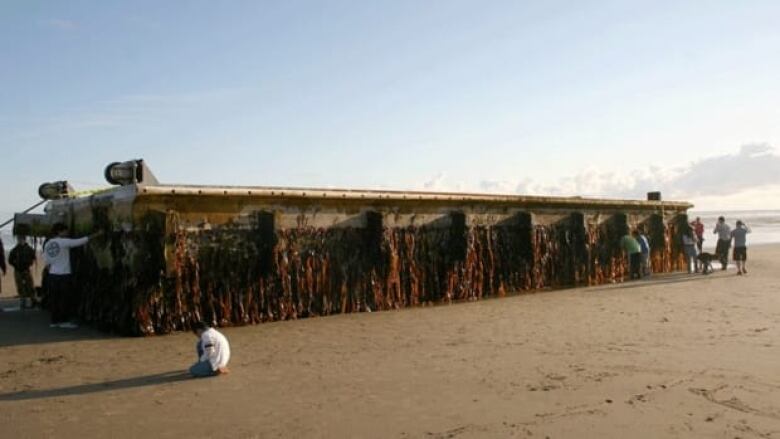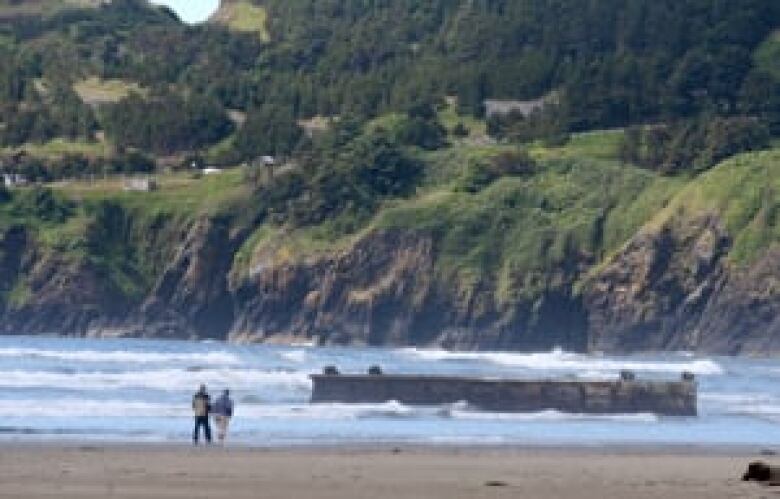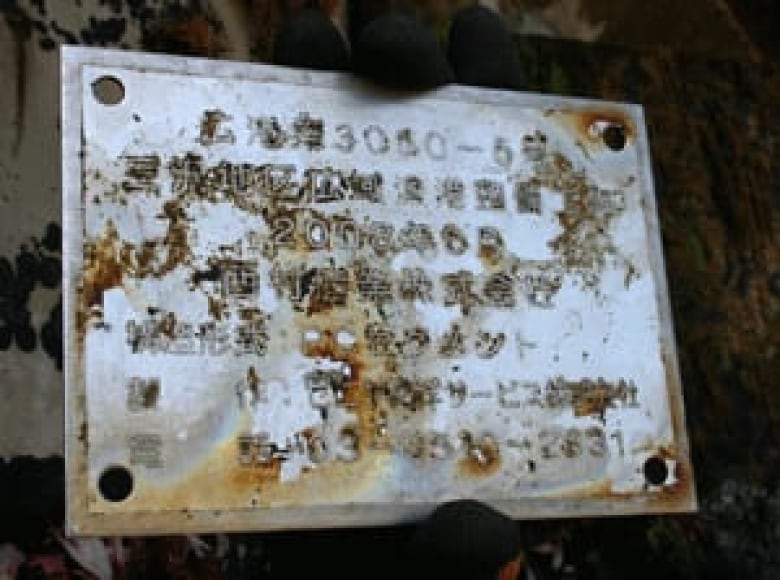Giant dock dislodged by Japanese tsunami washes up in Oregon

When the tsunami hit the northern coast of Japan last year, the waves ripped four dock floats the size of freight-train boxcars from their pilings in the fishing port of Misawa and turned them over to the whims of wind and currents.
Along for the ride were hundreds of millions of individual organisms, including a tiny species of crab, a species of algae and a little starfish, all native to Japan. Thecargo has scientists worried that the species might get a chance to spread out on the West Coast anddisrupt native species.
"This is a very clear threat," said John Chapman, a research scientist at Oregon State University's Hatfield Marine Science Center in Newport, Ore., less than two kilometres south of Agate Beach, where the dock float washed up early Tuesday morning.
"It's exactly like saying you threw a bowling ball into a china shop. It's going to break something. But will it be valuable or cheap glass? It's incredibly difficult to predict what will happen next."
Burying creatures a possibility
Plans were being considered by state authorities to scrape all the living things off the dock and bury them in the sand, so they would not spread, Chapman said.
While scientists expect much of the floating debris to follow the currents to the Great Pacific Garbage Patch, an accumulation of millions of tons of small bits of plastic floating in the northern Pacific, tsunami debris that can catch the wind is making its way to North America. In recent weeks, a soccer ball washed up in Alaska, and a Harley Davidson motorcycle in a shipping container ended upin British Columbia.

Just how the dock float150 tonnes of concrete and steel measuring 20 metres long,six metres wide and two metres highhappened to turn up on Agate Beach a mile north of Newport was probably determined within sight of land in Japan, said Jan Hafner, a computer programmer in the University of Hawaii's International Pacific Research Center, which is tracking the 1.4 million tonnes of tsunami debris estimated to still be floating across the Pacific.
That's where the winds, currents and tides are most variable, because of changes in the coastline and the features of the land, even for two objects a few yards apart, he said. Once the dock float got into the ocean, it was pushed steadily by the prevailing westerly winds and the North Pacific current.
"If you have leaves falling from a tree ... one leaf will be moving in a slightly different direction from another one," Hafner said. "Over time, the differences get bigger and bigger and bigger.
"Something similar is happening on the ocean."
Broke loose in Misawa port
After it ran ashore on Tuesday, the Japanese Consulate was able to track down the origin of the dock float from a plaque bolted to it commemorating its installation in June 2008. Deputy consul Hirofumi Murabayashi said from Portland, Ore., on Wednesday that it was one of four owned by Aomori Prefecture that broke loose from the port of Misawa on the northern tip of the main island during the tsunami.

Akihisa Sato, an engineer with Zeniya Kaiyo Service, the dock's Tokyo-based manufacturer, said the docks were used for loading fish onto trucks. One of them turned up several weeksafter the tsunamion an island south of Misawa, but the other two are still missing.
U.S. Senator Ron Wyden of Oregon called on the National Oceanic and Atmospheric Administration to redouble its efforts to track the debris, saying something as big as the dock could pose a danger to ships at sea.
NOAA's tsunami marine debris co-ordinator, Ruth Yender, said if the Pacific were shrunk to the size of a football field, something like the dock would be the size of a human hair, making it very difficult to monitor, even from satellites.
A radiation check of the dock came up negative, which was to be expected if the dock broke loose before the nuclear power plant accident triggered by the waves, said Chris Havel, spokesman for the Oregon Department of Parks and Recreation, which is overseeing removal of the dock.
Dock contains whole community
Chapman said the dock float was covered with masses of algae, kelp, barnacles, mussels and other organisms. One square-foot area weighed four kilograms.
"This is a whole, intact, very diverse community that floated across from Japan to here," he said. "That doesn't happen with a log or a thrown-out tire. I've never seen anything like this."
Of particular concern was a small crab that has run wild on the East Coast but not shown up yet on the West Coast and a species of algae that has hit Southern California but not Oregon. The starfish, measuring about three inches across, also appears to be new to U.S. shores.
"It's almost certainly true that most of the things on this have not been introduced to this coast yet," Chapman said. "We're going to see more of these things coming."
Tom Cleveland, a housekeeping supervisor at some nearby beachfront condominiums, said people curious to see it have been jamming up traffic at a beach parking lot.
"Everybody and their brother has been here looking at it and checking it out," Cleveland said. "Obviously, we knew things would be coming our way, but I didn't expect anything this size."












_(720p).jpg)


 OFFICIAL HD MUSIC VIDEO.jpg)
.jpg)



























































































